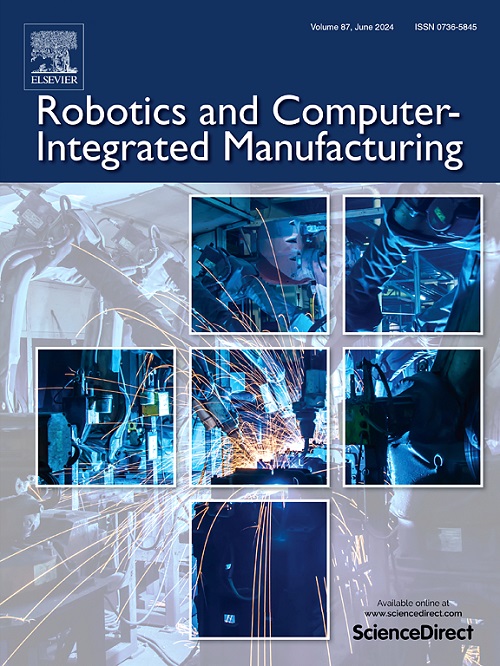Grid-to-Robot: Deep Wasserstein generative modeling of robot/power grid interaction using hybrid adversarial Residual Networks
IF 11.4
1区 计算机科学
Q1 COMPUTER SCIENCE, INTERDISCIPLINARY APPLICATIONS
引用次数: 0
Abstract
Smart Manufacturing (SM) is an important factor for driving innovation, enhancing operational efficiency, and increasing sustainable industrial growth in an increasingly competitive and resource-constrained world. However, it faces several challenges related to increasing energy consumption and climate change. The high energy demands of connected devices and robotic manipulators increase the carbon footprint. To resolve this issue, most enterprises are now transitioning to use Renewable Energy Sources (RES), and optimizing their power and energy usage, while holding the process efficient. To fully achieve this transition, a detailed power modeling of the robotic manufacturing system is crucial and, therefore, it is important to investigate this power modeling of the robotic manipulators’ consumption in a Smart Sustainable Manufacturing (SSM) to achieve the best power modeling results and better integrability analytics in optimal power planning of the robotic systems power supply. To this end, this paper presents a deep Generative Artificial Intelligence (GAI)-based modeling of robotic manipulators’ power supply interaction with the power grid, and RES. In the proposed system, which is powered by solar energy and the power grid, a SSM equipped with ten 6-Degrees of Freedom (DoF) robotic manipulators is considered in the presence of Battery Energy Storage Systems (BESSs). Subsequently, a Wasserstein Generative Adversarial Network with Gradient Penalty (WGAN-GP) is employed to generate synthetic data for the system alongside the real data, thereby expanding the analytical horizons across varying operational characteristics of the system. Following this, a Residual Networks (ResNet) is developed to comprehensively analyze and predictively model the power consumption of the manipulators and their interactions with the power supply resources. Finally, the proposed hybrid GAI modeling strategy is numerically evaluated across a broad spectrum of Key Performance Indicators (KPIs) (MSE= , MAE= , R2= 99.98%, MARE= , RMSPE= , MSRE= , RMSRE= , MAPE= , and Max Error= ), where these metrics demonstrate superior performance in power modeling. As a result, the concept of Grid-to-Robot (G2R) is introduced for the first time as a foundation for further advancements in SSM, enhancing sustainability and mitigating negative impacts on climate change while contributing to the development of an advanced manufacturing system.

网格到机器人:使用混合对抗性残差网络的机器人/电网交互的深度Wasserstein生成建模
智能制造(SM)是在竞争日益激烈和资源紧张的世界中推动创新、提高运营效率和促进可持续工业增长的重要因素。然而,它面临着与能源消耗增加和气候变化有关的几个挑战。连接设备和机器人操作的高能耗增加了碳足迹。为了解决这个问题,大多数企业现在正在过渡到使用可再生能源(RES),并优化其电力和能源使用,同时保持流程效率。为了充分实现这一转变,对机器人制造系统进行详细的功率建模是至关重要的,因此,研究智能可持续制造(SSM)中机器人机械手消耗的功率建模,以获得最佳的功率建模结果,并在机器人系统电源的最优功率规划中进行更好的可积性分析是很重要的。为此,本文提出了一种基于深度生成式人工智能(GAI)的机器人操作手电源与电网和res交互的建模方法。在该太阳能和电网供电系统中,考虑了在电池储能系统(BESSs)存在的情况下,配备10个6自由度(DoF)机器人操作手的SSM。随后,采用带有梯度惩罚的Wasserstein生成对抗网络(WGAN-GP)与真实数据一起为系统生成合成数据,从而扩展了系统不同操作特征的分析视野。在此基础上,建立了一个残差网络(ResNet),对机械臂的功耗及其与供电资源的相互作用进行综合分析和预测建模。最后,对所提出的混合GAI建模策略进行了广泛的关键性能指标(kpi)的数值评估(MSE= 10−4,MAE= 3.6×10−3,R2= 99.98%, MARE= 1.97×10−2,RMSPE= 8.83×10−2%,MSRE= 7.8×10−3,RMSRE= 8.84×10−2,MAPE= 1.97×10−2%,Max Error= 2.04×10−2),其中这些指标在功率建模中表现出卓越的性能。因此,网格到机器人(G2R)的概念首次被引入,作为SSM进一步发展的基础,增强可持续性,减轻对气候变化的负面影响,同时促进先进制造系统的发展。
本文章由计算机程序翻译,如有差异,请以英文原文为准。
求助全文
约1分钟内获得全文
求助全文
来源期刊
CiteScore
24.10
自引率
13.50%
发文量
160
审稿时长
50 days
期刊介绍:
The journal, Robotics and Computer-Integrated Manufacturing, focuses on sharing research applications that contribute to the development of new or enhanced robotics, manufacturing technologies, and innovative manufacturing strategies that are relevant to industry. Papers that combine theory and experimental validation are preferred, while review papers on current robotics and manufacturing issues are also considered. However, papers on traditional machining processes, modeling and simulation, supply chain management, and resource optimization are generally not within the scope of the journal, as there are more appropriate journals for these topics. Similarly, papers that are overly theoretical or mathematical will be directed to other suitable journals. The journal welcomes original papers in areas such as industrial robotics, human-robot collaboration in manufacturing, cloud-based manufacturing, cyber-physical production systems, big data analytics in manufacturing, smart mechatronics, machine learning, adaptive and sustainable manufacturing, and other fields involving unique manufacturing technologies.

 求助内容:
求助内容: 应助结果提醒方式:
应助结果提醒方式:


